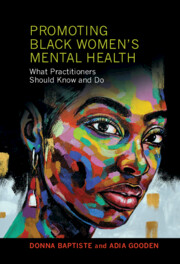Book contents
- Promoting Black Women’s Mental Health
- Promoting Black Women’s Mental Health
- Copyright page
- Contents
- Figures
- Tables
- Contributors
- Introduction
- Part I Black Women in Context
- Part II Therapy Contexts
- Part III Core Themes in Black Women’s Stress and Distress
- Part IV Helping Black Women Recover and Thrive
- Appendix
- Index
- References
Part IV - Helping Black Women Recover and Thrive
Published online by Cambridge University Press: 22 June 2023
- Promoting Black Women’s Mental Health
- Promoting Black Women’s Mental Health
- Copyright page
- Contents
- Figures
- Tables
- Contributors
- Introduction
- Part I Black Women in Context
- Part II Therapy Contexts
- Part III Core Themes in Black Women’s Stress and Distress
- Part IV Helping Black Women Recover and Thrive
- Appendix
- Index
- References
Summary

- Type
- Chapter
- Information
- Promoting Black Women's Mental HealthWhat Practitioners Should Know and Do, pp. 309 - 389Publisher: Cambridge University PressPrint publication year: 2023



